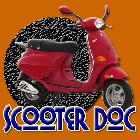Motor Scooters: The oily path of safety
Site Map
What's New
Features
Scooters from Amazon.comYes Man, Scooters in Film
Larry Crowne and scootering
Helmet Free scootering
Scooters in a failing economy
Scooter Economy
Scooter ROI Analysis
Scooter pays for itself
Types of Motorscooters
Why ride a scooter?
Motorscooter FAQ
Buying Scooters Online
Join Our Mailing List
Recommend this site
Scooter Inspiration
Scooter EconomyMotorscooter Advantages
Motorscooter Disadvantages
Motorscooter Books
Motor Scooter Poetry
Business Scooter Travel
Motorscooter Posters
Motorscooters in California
Scooting in the UK
Green Scooting in China
Scooting in Italy
Motorscooters in Iraq
Motor Scooter History
The Ice-Cream Scooter
Pets and Motorscooters
RVs and Motorscooters
Gas vs. Electric Scooters?
Put-putting Pleasures
Recommended Scooters
Scooter Culture
Larry Crowne (film)
Dating and Scooter Culture
Motorscooter Freedom
Motor Scooter Image
Scooter Lib
Back to School on a scooter
Motor Scooter Music
Motorscooter Camping
Types of Motorscooters
Classic Motor ScootersItalian Motor Scooters
The Vespa Motorscooter
The Aprilia Motorscooter
Falcon Electric Scooters
50cc Motorscooters
Kymco Motorscooters
GT Chaunl Scooters
Chinese Motor Scooters
TANK Motorscooters
The RoadRunner Scooter
Roketa Motorscooters
The I-scooter
Moped Scooters
Mopeds
Scooter Choices
Best Scooter DealsThe Performance Scooter
The Luxury Scooter
The Minimalist Scooter
The Classic Scooter
The Basic Scooter
The I-scooter
The Electric Scooter
Stand-up Scooters
The Mobility Scooter
Used Motorscooters
California Legal Scooters
Toy Scooters
Practical matters
Trouble starting a scooterScooters and the Environment
Scooter Return On Investment Analysis
Motor Scooter Repair
The Scooter Commute
Scooter Repair Shops
Scooter Replacement Parts
Vespa Repair
Scheduled Maintenance
Fuel Efficient Driving
Essential Scooterist Kit
Passengers on a Scooter
Motor Scooter parking
Using the Kick Starter
Motor Scooter Batteries
Motor Scooter Stands
Rotating a Scooter
Cargo Storage Issues
Chinese Scooter Alarms
Scooter Roadside Assistance
Affordable Insurance
Scootering in groups
Motorscooter safety
Motorscooter SafetyDriving a Motorscooter
MSF Manual: Your Scooter
Scooters and Potholes
Important, before you drive
Motorscooter Helmets
All-weather Scootering
The Oily Path of Safety
Motorscooter Journal
Motorscooter JournalOff-highway scooter routes
The Scooterdoc
Scooter Choice Ethics
India Shuns Scooters
Left-handed Motorscooters
Other Types of Scooters
Mobility ScootersScooter-inspired Vehicles
Electric Motorscooters
The Three-wheel Scooter

Vespa Service In
Southern California
The Oily Path of Safety
"Your sitee is good! Cheeras! Hello!!!! This is my first visit.... I found your site to be one of the most interesting websites on the Internet. It is very helpful site. Thank you much for your work.... Cheers!"
One does not wear seat belts on a motorscooter. One of the great dangers of scooter-riding is that hitting a bump or pothole that would simply shake one up in a car and perhaps bottom out the springs, when encountered at speed on a scooter is likely to unseat the driver or passenger and very possibly result in injury. The scooter rider must always be prepared to slow for bumps, dips, holes, sacks of chicken feed, badgers, and other random flotsam that present a substantial mass. It's not always easy to see that all-important vertical contour of the road ahead, but one interesting property of well-traveled roads does give one a series if clear clues.
The gravitational force whose standard unit (the G force) is based on the strength of the Earth's gravitational field, exerts a constant downward pull on a stationary vehicle. Should that vehicle experience upward or downward acceleration however, that G force will increase and decrease accordingly – when traversing past a hump in the road, the G force is vastly reduced, possibly to less than 0 temporarily if the vehicle hits the bump with enough speed to leave the ground briefly. When bottoming out in a dip, however, the G force can be much greater than 1, as shocks and springs are compressed to take the jolt. Okay, you already knew all that.
Cars drip oil – some more than others but that is not the point here. If there is a drip forming below the crankcase, being pulled down by gravity, it is statistically more likely to drop when the G force is at its greatest and least likely when that force is minimal. We have all learnt to avoid driving in the oil path down the middle of the lane for obvious safety reasons, but if we pay close attention to that oil path, it can tell us a great deal about the vertical contour of the road ahead – far more than we can clearly see from simply looking at the road itself. Areas where the oil-path sprawl into a large dark spot are points in the road where a great deal of oil has dripped, where the gravitational pull on vehicles is high, where you may bottom out your springs. Those points where the oil-path is thin, indistinct, or even nonexistent, indicate places in your path where your vehicle (and you) may become temporarily and perhaps dangerously weightless and airborne. The oil-path ahead provides an extremely accurate measure of the upcoming vertical dynamic of your vehicle and can thus often be used to anticipate and avert untoward occurrences. [illustration to come] Note that some asphalt and other surfaces do no always show the oil-path while the concrete shows it nicely.
Bookmark this page to:
